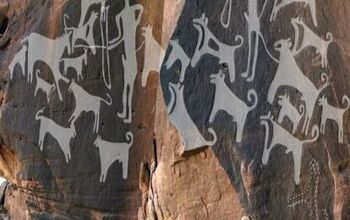Ancient Dogs Provide Clues About North America’s Early Inhabitants

New research out of the University of Illinois is using the DNA of ancient North American dogs to study the relationship of dogs and humans throughout history. Their findings also provide insight into ancient human behavior and migratory patterns.
Now, before you write this off as a total snoozefest, read on, because they actually discovered some pretty cool stuff about the age-old relationship between people and pooches!
To say that the special bond humans and dogs have developed has been advantageous for both species would be an understatement –we got their unwavering love, companionship and protection, and they got access to new food sources, the protection of living in human encampments and eventually, were able to migrate around the world with their human companions.
Related: Study Shows Urban Pet Owners Pay More Rent And Have Less Choice In Apartments
That said, the relationship between ancient dogs and humans wasn’t always love, sloppy kisses and snuggles: dogs were sometimes used as “beasts of burden,” helping to carry heavy loads and pull sleds. And on “special occasions” they were sometimes even served as food (yikes!).
Thankfully for North American pooches, our eating customs have changed and canine is no longer part of a well-balanced diet.
The authors of the study looked at DNA samples from canine remains from burial sites all over North America, including Colorado, British Columbia and the Janey B. Goode site near the ancient city of Cahokia, which was located close to present-day St. Louis.
Related: Study: Dog’s Inner Poop Compass Lines Up With Earth’s Axis
The area around Janey B. Goode was active between 1,400 and 1,000 years ago, while Cahokia rose up as North America’s first metropolitan area between 1,000 and 700 years ago, and the differences between ancient dog DNA from the two sites tells the story of a fluid and changing relationship between people and their canine companions.
Dozens of dogs were found ceremonially buried at Janey B. Goode, which indicates that people there had a special reverence for pooches. While most dogs were buried individually, some were placed back-to-back in pairs.
In Cahokia, dog remains (sometimes burned) were occasionally found with food debris, suggesting that dogs were sometimes used as a food source. Dog burials during the same time period were also rare. It’s interesting to think about what may have happened in the hundreds of years in between that led to these changes, especially when you think about our present day relationship to pooches.
The researchers also found greater diversity in ancient dog DNA than had previously been discovered; however, in certain regions, there was very low genetic variability between the dogs, which suggests that even then, humans were engaging in dog breeding.
Not only that, but many of the genetic samples showed significant similarities to American wolves, which indicated that some dogs were interbred with wolves or were even straight-up domesticated American wolves. Cool, right? Really, the main takeaway here is that hey –we probably had pet wolves (“Game of Thrones” style) back in the day, and that’s just pretty damned awesome.
For now, more studies of ancient dogs are in the works, and researchers hope to discover even more about both canine and human behavior, as well as North American customs dating back to ancient times. Three cheers for history!
[Source: Science Daily]

Christina Peden is a lifelong animal lover and avid wordsmith. She lives in Toronto with her boyfriend Ryan where they are proud pet parents to puppy, Matilda and cat, Oscar. In her spare time, she can be found enjoying Toronto, Canada's all-too-short patio season, taking advantage of the city's numerous parks or curled up with a good book.
More by Christina Peden























